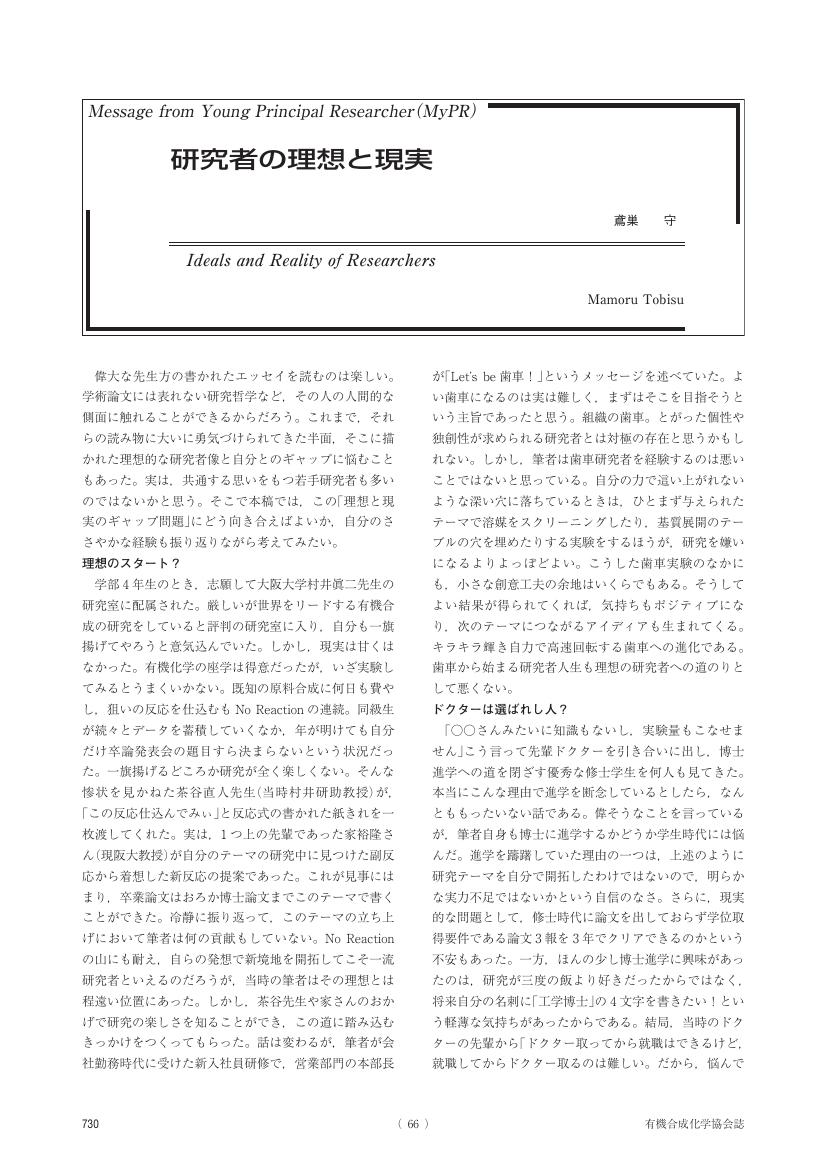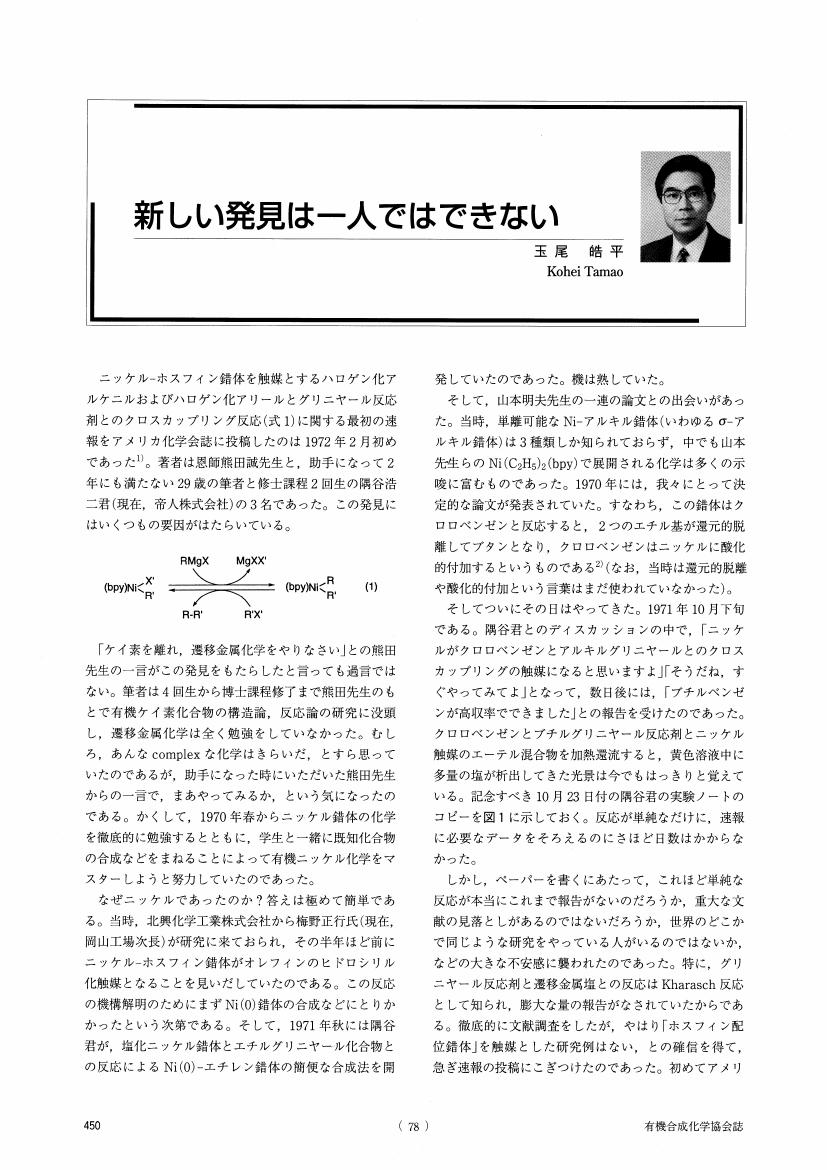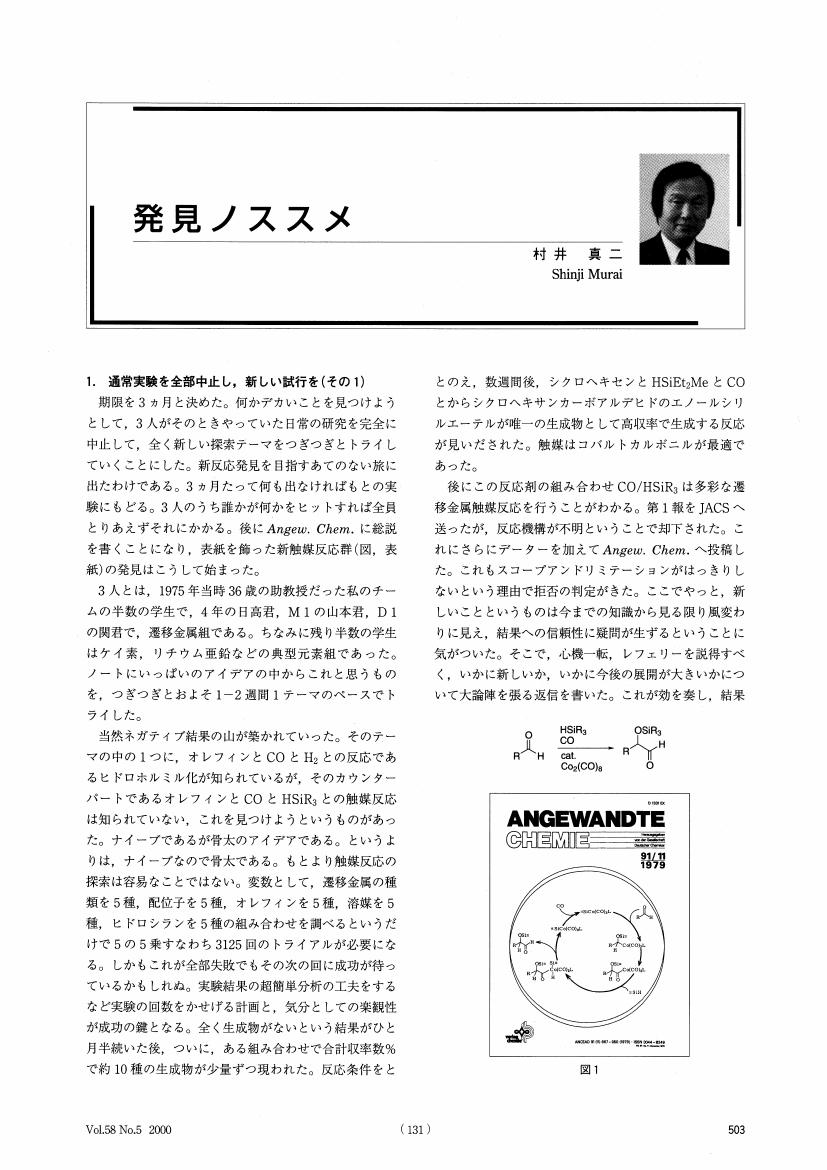202 0 0 0 OA 研究者の理想と現実
- 著者
- 鳶巣 守
- 出版者
- 公益社団法人 有機合成化学協会
- 雑誌
- 有機合成化学協会誌 (ISSN:00379980)
- 巻号頁・発行日
- vol.78, no.7, pp.730-732, 2020-07-01 (Released:2020-07-09)
51 0 0 0 OA 化学について私が知っている二,三の事柄
- 著者
- 伊藤 慎庫
- 出版者
- 公益社団法人 有機合成化学協会
- 雑誌
- 有機合成化学協会誌 (ISSN:00379980)
- 巻号頁・発行日
- vol.80, no.1, pp.66-68, 2022-01-01 (Released:2022-01-13)
- 参考文献数
- 5
50 0 0 0 OA 若手PIを目指した私の心得
- 著者
- 中尾 佳亮
- 出版者
- 公益社団法人 有機合成化学協会
- 雑誌
- 有機合成化学協会誌 (ISSN:00379980)
- 巻号頁・発行日
- vol.76, no.4, pp.370-371, 2018-04-01 (Released:2018-04-06)
46 0 0 0 OA 振り返ってみれば
- 著者
- 福山 透
- 出版者
- 公益社団法人 有機合成化学協会
- 雑誌
- 有機合成化学協会誌 (ISSN:00379980)
- 巻号頁・発行日
- vol.81, no.2, pp.141-173, 2023-02-01 (Released:2023-02-09)
- 参考文献数
- 150
22 0 0 0 OA 院生時代の漠然とした不安を克服するには
- 著者
- 松永 茂樹
- 出版者
- 公益社団法人 有機合成化学協会
- 雑誌
- 有機合成化学協会誌 (ISSN:00379980)
- 巻号頁・発行日
- vol.77, no.1, pp.75-77, 2019-01-01 (Released:2019-01-12)
20 0 0 0 OA 新しい発見は一人ではできない
- 著者
- 玉尾 皓平
- 出版者
- 公益社団法人 有機合成化学協会
- 雑誌
- 有機合成化学協会誌 (ISSN:00379980)
- 巻号頁・発行日
- vol.58, no.5, pp.450-452, 2000-05-01 (Released:2009-11-13)
- 参考文献数
- 5
12 0 0 0 OA 発見ノススメ
- 著者
- 村井 真二
- 出版者
- 公益社団法人 有機合成化学協会
- 雑誌
- 有機合成化学協会誌 (ISSN:00379980)
- 巻号頁・発行日
- vol.58, no.5, pp.503-505, 2000-05-01 (Released:2009-11-13)
- 参考文献数
- 3
9 0 0 0 OA 合成化学者による生命現象解明へのアプローチ~生体直交型反応の開発~
- 著者
- 下山 敦史
- 出版者
- 公益社団法人 有機合成化学協会
- 雑誌
- 有機合成化学協会誌 (ISSN:00379980)
- 巻号頁・発行日
- vol.72, no.3, pp.303-304, 2014-03-01 (Released:2014-04-21)
- 参考文献数
- 11
Investigating the function of native biomolecules is an important but challenging task due to the highly complex nature of biological systems. To understand complex biological systems in terms of simple biomolecular interactions, organic chemists have developed many bioorthogonal reactions over the past few years. These bioorthogonal reactions have been applied for the efficient construction of functionalized biomolecules. In this mini review, the development and the applications of such bioorthogonal reactions are described.
8 0 0 0 OA 3次元に共役する大環状分子の芳香族性
- 著者
- 福永 隼也
- 出版者
- 公益社団法人 有機合成化学協会
- 雑誌
- 有機合成化学協会誌 (ISSN:00379980)
- 巻号頁・発行日
- vol.81, no.6, pp.607-608, 2023-06-01 (Released:2023-06-07)
- 参考文献数
- 7
Aromaticity is an important concept that controls the stability, electronic property and reactivity of π-conjugated compounds. The conventional understanding of aromaticity, however, often fails to explain the behavior of compounds with highly complicated networks. This review highlights the recent development of syntheses of 3D π-conjugated macrocycles and discussions about aromaticity in 3D π-conjugated systems.
8 0 0 0 OA 時間を空間で制御する合成化学
- 著者
- 吉田 潤一
- 出版者
- 公益社団法人 有機合成化学協会
- 雑誌
- 有機合成化学協会誌 (ISSN:00379980)
- 巻号頁・発行日
- vol.76, no.4, pp.373-375, 2018-04-01 (Released:2018-04-06)
- 参考文献数
- 15
- 著者
- 張本 尚 石垣 侑祐
- 出版者
- 公益社団法人 有機合成化学協会
- 雑誌
- 有機合成化学協会誌 (ISSN:00379980)
- 巻号頁・発行日
- vol.81, no.10, pp.963-977, 2023-10-01 (Released:2023-10-05)
- 参考文献数
- 40
In recent years, near-infrared (NIR) dyes, exhibiting absorption in the NIR region (750-2500 nm), has been applied to various optical applications such as security marking, photovoltaic cells and chemotherapy of deep tissues in vivo. Electrochromic systems capable of switching NIR absorption are attractive from the viewpoint of applications for material and life science, and thus several examples have been reported to date. The development of organic-based materials is needed to reduce the environmental impact and improve biocompatibility. However, since the redox states of organic NIR dyes are generally unstable, the switching of NIR absorption based on quantitative redox interconversion is still a challenging issue regarding reversibility and durability during their interconversion. To construct organic electrochromic systems capable of ON/OFF switching of NIR-absorbing properties, we have focused on the non-aromatic π-conjugated para-quinodimethane (p-QD) skeleton. Herein, we have shown several studies on the synthesis and functional control of NIR electrochromic molecules based on redox-active p-QD scaffolds. We have elucidated the spectroscopic and electrochemical properties of various arylated quinodimethane derivatives and demonstrated that p-QD building blocks can be versatile components for the development of NIR switchable organic electrochromic systems.
7 0 0 0 ハロゲン化チエニルジケトンの機械刺激に応答する室温りん光機能
- 著者
- 谷 洋介 小村 真央
- 出版者
- 公益社団法人 有機合成化学協会
- 雑誌
- 有機合成化学協会誌 (ISSN:00379980)
- 巻号頁・発行日
- vol.81, no.5, pp.492-500, 2023-05-01 (Released:2023-05-10)
- 参考文献数
- 42
Phosphorescence is a unique luminescence property with a number of advantages that are complementary to those of fluorescence. However, achieving efficient room-temperature phosphorescence (RTP) using metal-free organic molecules is a challenging task owing to the spin-forbidden nature of phosphorescence. Extensive research in the last decade has revealed that decent RTP can be obtained from organic crystals based on the suppression of nonradiative decay. Nonetheless, once the rigid crystalline lattice is destroyed by applying mechanical stimuli, such RTP often disappears. We have recently developed heteroaromatic 1,2-diketones as a novel scaffold of organic RTP. Unlike conventional phosphors, the diketones exhibit efficient RTP in various noncrystalline states/environments. This article describes the RTP of halogenated thienyl diketone derivatives, focusing on their response to mechanical stimuli and the multiple and indispensable roles of halogens therein.
7 0 0 0 1,3-双極子としての性質を崩して展開する有機アジドの合成化学
- 著者
- 谷本 裕樹
- 出版者
- 公益社団法人 有機合成化学協会
- 雑誌
- 有機合成化学協会誌 (ISSN:00379980)
- 巻号頁・発行日
- vol.80, no.12, pp.1100-1112, 2022-12-01 (Released:2022-12-06)
- 参考文献数
- 43
Organic azides are well-known for the synthetic organic reactions by their energetic characteristics and the click functionality connecting two components. Especially in click chemistry, the azido groups as 1,3-dipolar play a key role in chemical biology. On the other hand, azido groups can also work as nucleophiles possessing diazonium leaving groups and as electrophiles, but the low reactivity has avoided their use. Herein, we disclose our synthetic achievements in the non-1,3-dipolar use of organic azides. As nucleophiles, the organic azides with allyl/propargyl cations and sulfonium ions gave the appropriate products, including C-C bond migration. We also demonstrated that the intramolecular hydrogen bonding interaction promoted the electrophilicity and suppressed the nucleophilicity of the azides to achieve site-selective conjugation. Furthermore, β-elimination followed by condensation converted the azido groups at the carbonyl α-position to the different click functional groups. This site-selective azido group conversion enabled the undistinguishable triazide molecule to the distinguishable triple-click scaffold compound possessing three different click groups.
6 0 0 0 OA 火薬工業界の展望
- 著者
- 千藤 三千造
- 出版者
- 公益社団法人 有機合成化学協会
- 雑誌
- 有機合成化学協会誌 (ISSN:00379980)
- 巻号頁・発行日
- vol.14, no.7, pp.472-475, 1956-07-01 (Released:2010-10-20)
6 0 0 0 モレキュラーシーブの新たな使用法
- 著者
- 安川 知宏 久田 智也 中島 華子 増田 隆介 北之園 拓 山下 恭弘 小林 修
- 出版者
- 公益社団法人 有機合成化学協会
- 雑誌
- 有機合成化学協会誌 (ISSN:00379980)
- 巻号頁・発行日
- vol.81, no.4, pp.353-361, 2023-04-01 (Released:2023-04-08)
- 参考文献数
- 57
Molecular sieves are type A zeolites with specific sized pores and are commonly used in organic synthesis to capture small molecules such as water. In addition to their trapping effect, they also have acidic and basic active sites and are used as solid acid-base catalysts. Usually, heat-drying treatments are performed prior to use, but the heat treatment methods, such as microwave ovens or heat guns, are not standardized, which could cause problems in reproducibility of reactions. Particularly, for reactions requiring acid/base sites of molecular sieves, these treatment methods are considered more sensitive because the structure of the active sites changes upon heating. In this article, we propose new methods of activation when using molecular sieves and their application to continuous-flow reactions.
- 著者
- 石垣 侑祐
- 出版者
- 公益社団法人 有機合成化学協会
- 雑誌
- 有機合成化学協会誌 (ISSN:00379980)
- 巻号頁・発行日
- vol.79, no.4, pp.290-299, 2021-04-01 (Released:2021-04-07)
- 参考文献数
- 35
The carbon-carbon covalent bond is one of the most basic concept in organic chemistry. Bond length, bond angle, and torsion angle among carbon atoms are nearly constant on the basis of the bond order and hybrid orbitals. On the other hand, highly strained hydrocarbons such as sterically-congested and/or curved polycyclic aromatic hydrocarbons have attracted much attention with regard to their characteristic features. Regarding the C-C single bond, whose standard length is 1.54 Å, several attempts have been made to elongate the C-C single bond to gain new insight into the chemical bond and understand what happens at the limits of a bond. In contrast to the standard C=C double bond with planarity, the overcrowded ethylenes (OCEs) with bulky substituents can adopt anti-folded, syn-folded and/or twisted forms due to the steric hindrance around the central C=C double bond, and thus many OCEs exhibit photo- and thermochromic behavior upon exposure to external stimuli. Herein, we focus on redox-active hydrocarbons with two dibenzocycloheptatriene units, where unprecedented flexible C-C bonds based on extremely elongated C-C single bonds and control of HOMO levels were demonstrated. Thus, these highly strained hydrocarbons could be promising candidates for the development of functional materials.
5 0 0 0 OA ある若手PIの回想
- 著者
- 大宮 寛久
- 出版者
- 公益社団法人 有機合成化学協会
- 雑誌
- 有機合成化学協会誌 (ISSN:00379980)
- 巻号頁・発行日
- vol.77, no.7, pp.732-734, 2019-07-01 (Released:2019-07-08)
5 0 0 0 空気酸化によって再生可能な光延試薬の開発と触媒的光延反応への応用
- 著者
- 谷口 剛史
- 出版者
- 公益社団法人 有機合成化学協会
- 雑誌
- 有機合成化学協会誌 (ISSN:00379980)
- 巻号頁・発行日
- vol.77, no.6, pp.584-595, 2019-06-01 (Released:2019-06-11)
- 参考文献数
- 41
- 被引用文献数
- 1
The Mitsunobu reaction is widely used for transformation of hydroxy groups into various functional groups and inversion of the stereochemistry of secondary alcohols in organic synthesis. The Mitsunobu reaction, however, has some serious problems that inhibit its application of the reaction to practical synthesis on large scales. Especially, the reaction requires hazardous azo reagents such as diethyl azodicarboxylate (DEAD) and produces large amounts of undesired waste that sometimes complicate purification of the desired products. We have recently developed catalytic Mitsunobu reactions using new azo reagents recyclable by iron-catalyzed aerobic oxidation. Ethyl 2-(3,4-dichlorophenyl)hydrazinecarboxylate and ethyl 2-(4-cyanophenyl)hydrazinecarboxylate (or their azo forms) were identified as good catalysts by our systematic investigation. The modified catalytic reaction using these azo reagents was applicable to broad scope of substrates. High thermal stability of the reagents was shown by SC-DSC analysis, suggested low explosive nature of these reagents.
5 0 0 0 OA 錯体合成から触媒機能の発掘,そしてまた錯体へ
- 著者
- 西山 久雄
- 出版者
- 公益社団法人 有機合成化学協会
- 雑誌
- 有機合成化学協会誌 (ISSN:00379980)
- 巻号頁・発行日
- vol.77, no.2, pp.189-191, 2019-02-01 (Released:2019-02-08)
- 参考文献数
- 16
- 被引用文献数
- 1
4 0 0 0 OA だから研究はやめられない
- 著者
- 岩渕 好治
- 出版者
- 公益社団法人 有機合成化学協会
- 雑誌
- 有機合成化学協会誌 (ISSN:00379980)
- 巻号頁・発行日
- vol.81, no.6, pp.626-629, 2023-06-01 (Released:2023-06-07)
- 参考文献数
- 9








